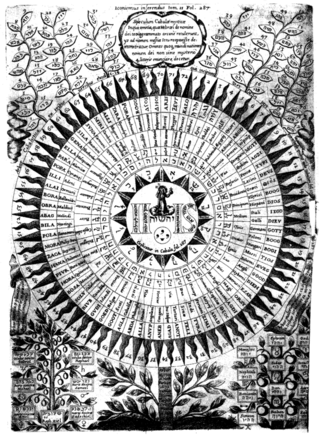Related Research Articles

Judaism has different names given to God, which are considered sacred: יהוה, אֲדֹנָי, אֵל, אֱלֹהִים, שַׁדַּי, and צְבָאוֹת ; some also include I Am that I Am. Early authorities considered other Hebrew names mere epithets or descriptions of God, and wrote that they and names in other languages may be written and erased freely. Some moderns advise special care even in these cases, and many Orthodox Jews have adopted the chumras of writing "G-d" instead of "God" in English or saying Ṭēt-Vav instead of Yōd-Hē for the number fifteen or Ṭēt-Zayin instead of Yōd-Vav for the Hebrew number sixteen.

Yahweh was an ancient Levantine deity who was venerated in Israel and Judah. Though no consensus exists regarding his origins, scholars generally contend that he is associated with Seir, Edom, Paran and Teman, and later with Canaan. His worship reaches back to at least the Early Iron Age, and likely to the Late Bronze Age, if not somewhat earlier.

Child sacrifice is the ritualistic killing of children in order to please or appease a deity, supernatural beings, or sacred social order, tribal, group or national loyalties in order to achieve a desired result. As such, it is a form of human sacrifice. Child sacrifice is thought to be an extreme extension of the idea that the more important the object of sacrifice, the more devout the person rendering it.

Baal, or Baʻal, was a title and honorific meaning 'owner' or 'lord' in the Northwest Semitic languages spoken in the Levant during antiquity. From its use among people, it came to be applied to gods. Scholars previously associated the theonym with solar cults and with a variety of unrelated patron deities, but inscriptions have shown that the name Ba'al was particularly associated with the storm and fertility god Hadad and his local manifestations.

El is a Northwest Semitic word meaning 'god' or 'deity', or referring to any one of multiple major ancient Near Eastern deities. A rarer form, 'ila, represents the predicate form in the Old Akkadian and Amorite languages. The word is derived from the Proto-Semitic *ʔil-.

There are various names of God, many of which enumerate the various qualities of a Supreme Being. The English word god is used by multiple religions as a noun to refer to different deities, or specifically to the Supreme Being, as denoted in English by the capitalized and uncapitalized terms God and god. Ancient cognate equivalents for the biblical Hebrew Elohim, one of the most common names of God in the Bible, include proto-Semitic El, biblical Aramaic Elah, and Arabic ilah. The personal or proper name for God in many of these languages may either be distinguished from such attributes, or homonymic. For example, in Judaism the tetragrammaton is sometimes related to the ancient Hebrew ehyeh. It is connected to the passage in Exodus 3:14 in which God gives his name as אֶהְיֶה אֲשֶׁר אֶהְיֶה, where the verb may be translated most basically as "I am that I am", "I shall be what I shall be", or "I shall be what I am". In the passage, YHWH, the personal name of God, is revealed directly to Moses.
Sanchuniathon, also known as Sanchoniatho the Berytian, was a Phoenician author. His three works, originally written in the Phoenician language, survive only in partial paraphrase and a summary of a Greek translation by Philo of Byblos recorded by the Christian bishop Eusebius. These few fragments comprise the most extended literary source concerning Phoenician religion in either Greek or Latin: Phoenician sources, along with all of Phoenician literature, were lost with the parchment on which they were written.

Mot was the Canaanite god of death and the Underworld. He was also known to the people of Ugarit and in Phoenicia, where Canaanite religion was widespread. The main source of information about Mot in Canaanite mythology comes from the texts discovered at Ugarit, but he is also mentioned in the surviving fragments of Philo of Byblos's Greek translation of the writings of the Phoenician Sanchuniathon.
Elyon or El Elyon, is an epithet that appears in the Hebrew Bible. ʾĒl ʿElyōn is usually rendered in English as "God Most High", and similarly in the Septuagint as ὁ Θεός ὁ ὕψιστος. The title ʿElyōn is a common topic of scholarly debate, sometimes interpreted as equal to the Abrahamic God, and otherwise theorized as a reference to a separate deity of its own kind, potentially above that of Yahweh.
Philo of Byblos, also known as Herennius Philon, was an antiquarian writer of grammatical, lexical and historical works in Greek. He is chiefly known for his Phoenician history assembled from the writings of Sanchuniathon.
Sydyk was the name of a deity appearing in a theogony provided by Roman-era Phoenician writer Philo of Byblos in an account preserved by Eusebius in his Praeparatio evangelica and attributed to the still earlier Sanchuniathon.
Ancient Semitic religion encompasses the polytheistic religions of the Semitic peoples from the ancient Near East and Northeast Africa. Since the term Semitic represents a rough category when referring to cultures, as opposed to languages, the definitive bounds of the term "ancient Semitic religion" are only approximate but exclude the religions of "non-Semitic" speakers of the region such as Egyptians, Elamites, Hittites, Hurrians, Mitanni, Urartians, Luwians, Minoans, Greeks, Phrygians, Lydians, Persians, Medes, Philistines and Parthians.

Canaanite religion was a group of ancient Semitic religions practiced by the Canaanites living in the ancient Levant from at least the early Bronze Age to the first centuries CE. Canaanite religion was polytheistic and in some cases monolatristic. It was influenced by neighboring cultures, particularly ancient Egyptian and Mesopotamian religious practices. The pantheon was headed by the god El and his consort Asherah, with other significant deities including Baal, Anat, Astarte, and Mot.
Baʿal Berith and El Berith are titles of a god or gods worshiped in Shechem, in ancient Canaan, according to the Bible.

Baalshamin, also called Baal Shamem and Baal Shamaim, was a Northwest Semitic god and a title applied to different gods at different places or times in ancient Middle Eastern inscriptions, especially in Canaan/Phoenicia and Syria. The title was most often applied to Hadad, who is also often titled just Ba‘al. Baalshamin was one of the two supreme gods and the sky god of pre-Islamic Palmyra in ancient Syria. There his attributes were the eagle and the lightning bolt, and he perhaps formed a triad with the lunar god Aglibol and the sun god Malakbel. The title was also applied to Zeus.

In Judaism, God has been conceived in a variety of ways. Traditionally, Judaism holds that Yahweh—that is, the god of Abraham, Isaac and Jacob, and the national god of the Israelites—delivered them from slavery in Egypt, and gave them the Law of Moses at Mount Sinai as described in the Torah. Jews traditionally believe in a monotheistic conception of God, characterized by both transcendence and immanence.

Lotan, also transliterated Lôtān, Litan, or Litānu, is a servant of the sea god Yam defeated by the storm god Hadad-Baʿal in the Ugaritic Baal Cycle. Lotan seems to have been prefigured by the serpent Têmtum represented in Syrian seals of the 18th–16th century BC, and finds a later reflex in the sea monster Leviathan, whose defeat at the hands of Yahweh is alluded to in the biblical Book of Job and in Isaiah 27:1. Lambert (2003) went as far as the claim that Isaiah 27:1 is a direct quote lifted from the Ugaritic text, correctly rendering Ugaritic bṯn "snake" as Hebrew nḥš "snake".

The Byblos clay cones inscriptions are Phoenician inscriptions on two clay cones discovered around 1950.

Phoenician–Punic literature is literature written in Phoenician, the language of the ancient civilization of Phoenicia, or in the Punic language that developed from Phoenician and was used in Ancient Carthage. It is surrounded by an aura of mystery due to the few preserved remains. All that is left is a series of inscriptions, few of which are of a purely literary nature, coins, fragments of Sanchuniathon's History and Mago's Treaty, the Greek translation of the voyage of Hanno the Navigator and a few lines in the Poenulus by Plautus.

Sakkun was a Phoenician god. He is known chiefly from theophoric names such as Sanchuniathon and Gisgo. As of 1940, his earliest appearance in epigraphical evidence is from the 5th century BC.
References
- ↑ Philo of Byblos 1981.
- ↑ Gray 1953, p. 281.
- ↑ van Kooten 2006, p. 120.
- ↑ Edwards 1991, p. 215.
- ↑ Lokkegaard 1954, p. 52.
- ↑ Albright 1957, p. 317, 57.
- ↑ Baumgartner 1981, p. 55.